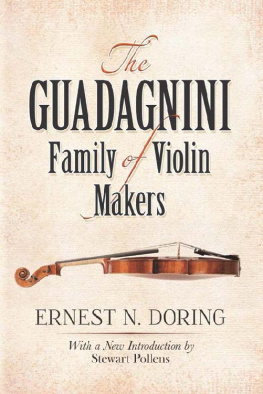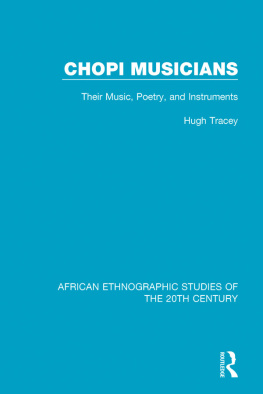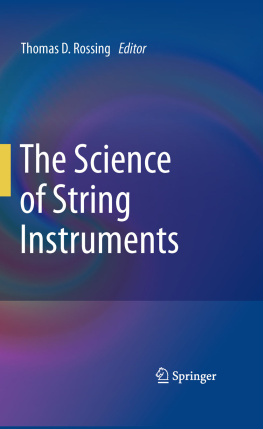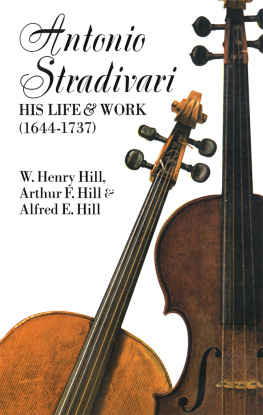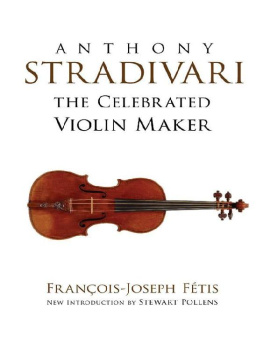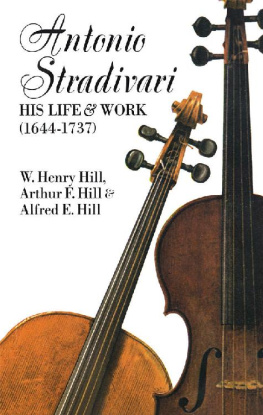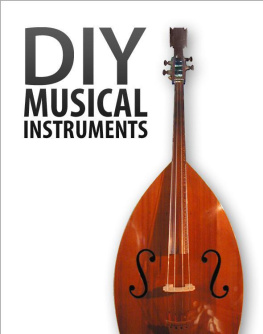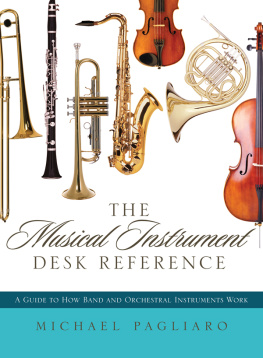The Guadagnini
Family of Violin
Makers
Ernest N. Doring
With a New Introduction by Stewart Pollens
Dover Publications, Inc.
Mineola, New York
D EDICATED TO
R EUBEN A. O LSON
I N G RATEFUL R ECOGNITION
Bibliographical Note
This Dover edition, first published in 2012, is an unabridged republication of the work originally published by William Lewis & Son, Chicago, in 1949. Stewart Pollens has prepared a new Introduction specially for this Dover edition.
Library of Congress Cataloging-in-Publication Data
Doring, Ernest N. (Ernest Nicholas), 1877-1955.
The Guadagnini family of violin makers / Ernest N. Doring;
With a New Introduction by Stewart Pollens.
pages ; cm
An unabridged republication of the work originally published by William Lewis & Son, Chicago, in 1949.
Includes bibliographical references and index.
ISBN-13: 978-0-486-49796-9
ISBN-10: 0-486-49796-8
1. Guadagnini, Giovanni Battista, d. 1786. 2. Violin makersItalyBiography. I. Pollens, Stewart. II. Title.
ML421.G77D6 2012
787.2'19092dc23
[B]
2012027016
Manufactured in the United States by Courier Corporation
49796801
www.doverpublications.com
Introduction to the Dover Edition
The violins of Giovanni Battista Guadagnini have long been favorites of professional musicians and are ranked closely behind those of Antonio Stradivari and Giuseppe Guarneri del Ges with regard to responsiveness, tonal quality, and projection. Despite several recent publications about the Guadagnini family and an exhibition devoted to instruments made by G. B. Guadagnini, Ernest N. Dorings The Guadagnini Family of Violin Makers, published in Chicago in 1949, remains the most comprehensive study of this familys life and work and includes a catalogue raisonn of their instruments. Ernest N. Doring worked for the Rudolph Wurlitzer Company alongside noted violin experts Rembert Wurlitzer and J. C. Freeman and later for William Lewis & Son, which first published this book. In compiling information, he had access to the archives and Guadagnini instruments handled by these firms as well as by Hamma & Company, Emil Herrmann, and several notable collectors. Dorings book was originally published in a limited edition of 1500; today second-hand copies are extremely scarce and fetch a premium in the specialized violin book market. This modestly priced Dover reprint brings Dorings classic to the general public for the first time.
Though archival research tends to answer longstanding questions about the life and work of violin makers, it often raises new issues that confound the experts. For example, Stefano Pios extensive investigation into violin-making in Venice and its environs (published in his Liuteri Sonadori: Venezia 1750-1870, Treviso, 2002, and Violin and Lute Makers of Venice 1640-1760, Treviso, 2004) failed to uncover any evidence of the purported violin maker Michele Deconets supposed apprenticeship with Domenico Montagnana, his membership in the Arte dei Marzeri (the guild to which instrument makers and musicians had to belong in order to work legally in Venice), or that he maintained a commercial establishment for making or selling musical instruments in that city or in Padua, where he is also believed to have worked. However, Pios research did reveal Deconet to be an itinerant musician and singer of songs in the piazza who probably could not even read music, which was a requirement for formal membership as a musician in the Arte dei Marzeri in Venice. Nevertheless, there is a sizable body of instruments fitted with printed labels bearing his name, as well as other instruments that have been attributed to him on the basis of their stylistic similarity to the labeled ones. Such instruments have been traded in good faith as authentic Deconets for over two hundred and fifty years, yet in the wake of Pios findings, owners and dealers of these violins now find themselves in a predicament as to how to market them.
Similarly, Duane Rosengards exhaustive research into the Guadagnini family, presented in his book Giovanni Battista Guadagnini (Haddonfield, 2000), failed to discover any record indicating that Lorenzo Guadagnini, the progenitor of this violin-making clan, ever made violins or apprenticed with Antonio Stradivari, despite violin labels that read LAURENTIUS GUADAGNINI /fecit Placentie, alumnus Anto-/nius Straduarius anno 17__ (and other wordings). Instead, Rosengard uncovered evidence that he worked as an innkeeper, butcher, and baker. Giovanni Battista, Lorenzos first son and the only one to go on to make violins, was born on June 23, 1711 in the small town of Bilegno, and not Piacenza as many biographers (including Doring) have speculated. He was to become the premier violin maker of a family that would include his two violin making sons, Giuseppe and Gaetano, as well as several grandsons, great-grandsons, and their progeny who plied the craft into the twentieth century.
In eighteenth-century italy, apprenticeships traditionally began at the age of twelve or thirteen, but there is no evidence that Giovanni Battista ever formally learned the craft of violin making in his native Bilegno, a town that is not known to have had a resident violin maker during Giovanni Battistas formative years there. In 1738, at the age of twenty-six, he left home and settled in Piacenza, where he married, became a member of the wood-workers guild, and evidently began making violins there by 1740. This is the earliest date found on a label in an extant G. B. Guadagnini violin and represents a rather a late start to begin a career in those days. In 1749 he and his family began an itinerant existence, leaving Piacenza for Milan, then resettling in Parma in 1758, and finally departing in 1771 for Turin, where he continued making violins until his death on September 18, 1786. These details regarding Lorenzo Guadagnini and G. B. Guadagninis birthplace, guild membership, and the precise dates of his relocations correct lacunae and a few minor inaccuracies in Dorings book.
Some historians suggest that G. B. Guadagnini spent several months in Cremona in 1758 prior to his arrival in Parma, and several of his instruments bear labels indicating that they were made in Cremona in that year. Labels subsequently printed in Parma state that he was Cremonese, which strictly speaking was untrue. Labels printed in his Turin period go so far as to state that he was also an alumnus, or former apprentice, of Antonio Stradivari; however, Stradivari died in 1737, so if Guadagnini passed through Cremona in 1758, he could not have worked with him, or with the two sons who assisted him, Omobono and Francesco, who died in 1742 and 1743. Nor is there any evidence that he apprenticed in his youth with Stradivari; if he had done so, why wait so many years to proclaim this on his labels? Clearly, Guadagnini misrepresented the facts to bolster his reputation as well as the desirability and price of his violins. in attempting to explain his relocations (which was not at all common with violin makers at that time), Doring suggests that he was so productive that he flooded each of these markets with instruments and then had to move on to greener pastures; however, he does consider Guadagninis appointment as court instrument maker in Parma and the subsequent political intrigue that led to the loss of his stipend as plausible reasons for his arrival and departure from that duchy.
One of the pivotal figures in Giovanni Guadagninis life was Count Ignazio Alessandro Cozio di Salabue, an amateur violinist and violin historian who became his principal patron during the Turin period. Between 1773 and 1776, Count Cozio acquired some fifty instruments from Guadagnini, and attempted to serve as the makers mentor by offering to lend him Antonio Stradivaris forms, patterns, and tools, which he had purchased in 1776 from Paolo Stradivari (Antonios youngest son and a merchant by profession). Writing in 1804, Count Cozio stated that Guadagnini made instruments under his supervision using Stradivaris violin forms and patterns, though Guadagninis instruments, in fact, bear little resemblance to those of Stradivari, and thus it is unlikely that he actually made use of these materials. The Count did collaborate in the finishing of some of Guadagninis instruments, for we know that he obtained instruments in the white and sent them to the Mantegazza brothers (active 1747-1801) in Milan for varnishing. Among the Counts letters and papers that are preserved in the Biblioteca Statale in Cremona are sheets of Guadagninis printed violin labels with a few of them cut out, further evidence of his involvement in the fabrication of Guadagninis violins. When offering violins to a fellow collector, Count Cozio priced Amati violins at 300 zecchini, the biggest and best Stradivari violins at 150 zecchini, other Strads at 80-100 zecchini, Bergonzis at 30-50 zecchini, and Guarneri and Guadagnini violins at 15-18 zecchini, which gives some indication of their relative worth at that time, as well as the reevaluations that have occurred since.

